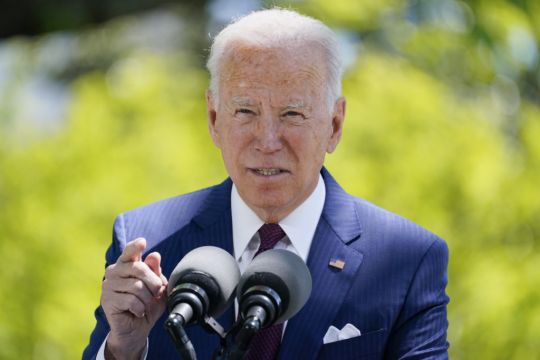Marking his first 100 days in office, US President Joe Biden will use his first joint address to Congress to pitch a 1.8 trillion dollar (£1.3 trillion) investment in children, families and education that would fundamentally transform the role government plays in American life.
Mr Biden will make his case before a pared-down gathering of mask-wearing legislators due to coronavirus restrictions, and in a US Capitol still surrounded by black fencing after insurrectionists protesting against his election occupied the very dais where he will stand.
In the nationally televised ritual of a president standing before Congress, Mr Biden will lay out a sweeping proposal for universal pre-school, two years of free community college, 225 billion dollars (£180 billion) for childcare and monthly payments of at least 250 dollars (£180) to parents.
His ideas reflect the frailties that were uncovered last year by the pandemic, and he will make the case that economic growth would best come from taxing the rich to help the middle class and the poor.

His speech will also provide an update on progress in combating the Covid-19 crisis he was elected to tame, showcasing hundreds of millions of vaccinations and relief cheques delivered to help offset the devastation wrought by a virus that has killed more than 573,000 people in the US.
He will also champion his 2.3 trillion-dollar (£1.65 trillion) infrastructure plan, a staggering figure to be financed solely by higher taxes on corporations.
Seizing an opportunity born of generational calamity, Mr Biden has embraced momentous action over incremental progress, with the goal of making the economy fairer and stronger. But he will be forced to thread the needle between Republicans who cry government overreach and some Democrats who fear he will not go far enough.
The Democratic president’s strategy is to sidestep the polarisation and make his appeal directly to voters. His prime-time speech will underscore a trio of central campaign promises: To manage the deadly pandemic, to turn down the tension in Washington and to restore faith in government as an effective force for good.
“He is a big-government Democrat, and he has not been at all reluctant to propose big initiatives in a response to a national crisis,” said Julian Zelizer, a Princeton University presidential historian.
Before I took office, I promised help was on the way. Just three months in, I’m proud to say help is here. We’ve delivered over 150 million relief checks, administered over 200 million shots, and are working hard to build back better every day.
— President Biden (@POTUS) April 24, 2021
Advertisement
No American politician has more familiarity with the presidential address to Congress than Mr Biden. He spent three decades in the audience as a senator and another eight years seated behind president Barack Obama during the annual address when he was vice president.
For the first time on Wednesday, a female vice president, Kamala Harris, will be seated behind the chief executive for the speech.
Mr Biden also knows that most of those seated before him have, like he did, looked at the president and envisioned themselves one day in his place. He has heard the memorable phrases and the long list of promises – often unmet – and seen the partisan reactions intensify as the years have hurried by.
He chose to delay this speech, typically given in the afterglow of a presidential inaugural. In doing so, he gave himself the chance to not simply speak of the pain of the Covid-19 crisis but also to talk about tangible progress in beating it back.
The setting will be unlike for any of his predecessors, with members of Congress spread out and socially distanced and many Republicans citing “scheduling conflicts” to explain their absence.







